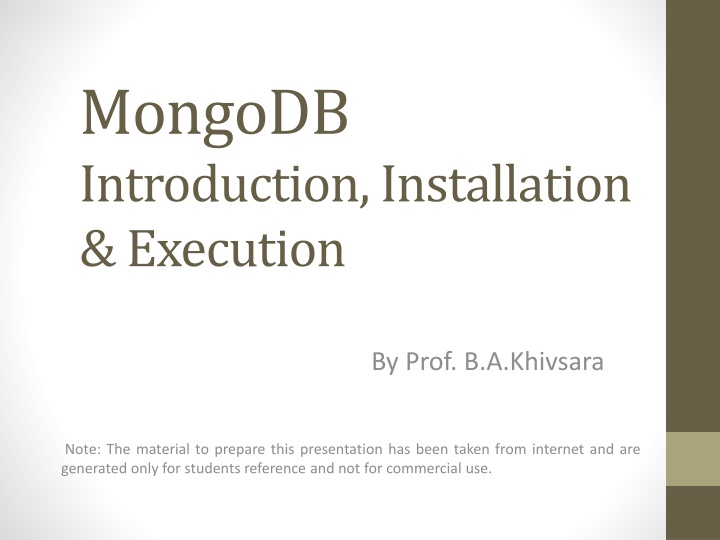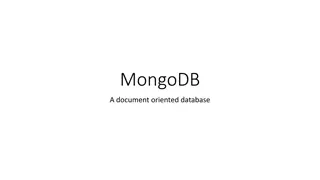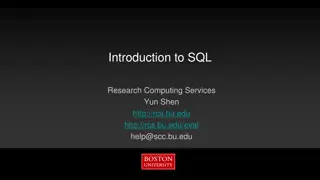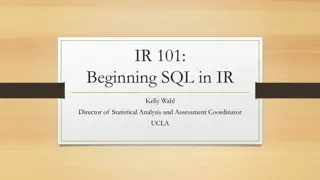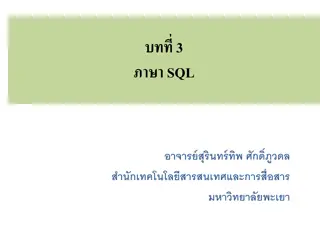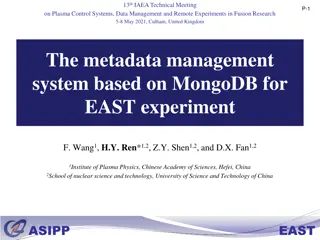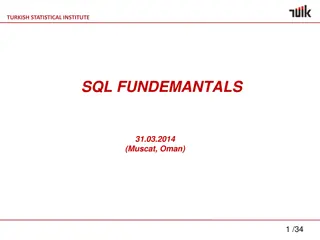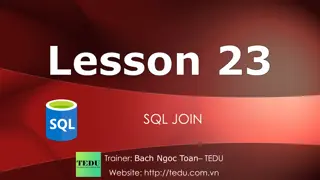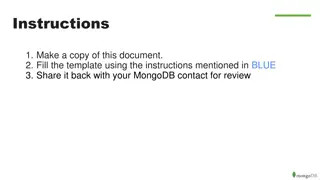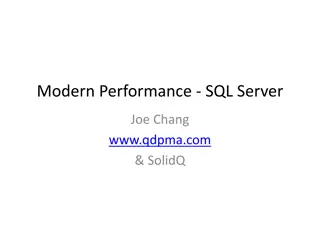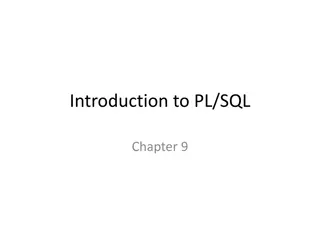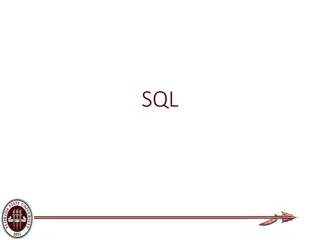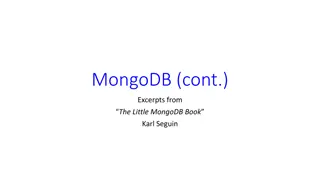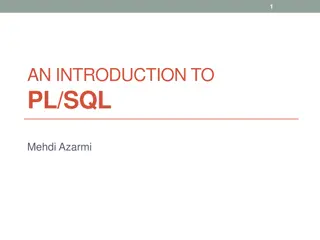Introduction to MongoDB and SQL: Key Differences and Features
The differences between SQL and NoSQL databases, focusing on MongoDB. Understand SQL characteristics, data manipulation, language, and transaction properties. Dive into real-world SQL database examples and discuss the significance of SQL in the global economy.
Download Presentation

Please find below an Image/Link to download the presentation.
The content on the website is provided AS IS for your information and personal use only. It may not be sold, licensed, or shared on other websites without obtaining consent from the author.If you encounter any issues during the download, it is possible that the publisher has removed the file from their server.
You are allowed to download the files provided on this website for personal or commercial use, subject to the condition that they are used lawfully. All files are the property of their respective owners.
The content on the website is provided AS IS for your information and personal use only. It may not be sold, licensed, or shared on other websites without obtaining consent from the author.
E N D
Presentation Transcript
MongoDB Introduction, Installation & Execution By Prof. B.A.Khivsara Note: The material to prepare this presentation has been taken from internet and are generated only for students reference and not for commercial use.
Outline Difference Between SQL and NoSQL Study of Open Source NOSQL Database MongoDB Installation, Basic CRUD operations, Execution
Difference Between SQL and NoSQL SQL Databases SQL Standard SQL Characteristics SQL Database Examples NoSQL Databases NoSQL Defintion General Characteristics NoSQL Database Types NoSQL Database Examples 28 February 2025 3
SQL Characteristics 28 February 2025 Data stored in tables Relationships represented by data 4 Data Manipulation Language Data Definition Language Transactions Abstraction from physical layer
Data Definition Language Schema defined at the start 28 February 2025 Create Table Constraints to define and enforce relationships Primary Key Foreign Key Etc. 5 Triggers to respond to Insert, Update , & Delete Stored Modules Alter Drop Security and Access Control
Data Manipulation Language (DML) 28 February 2025 Data manipulated with Select, Insert, Update, & Delete 6 Data Aggregation Compound statements Functions and Procedures Explicit transaction control
Transactions ACID Properties 28 February 2025 Atomic All of the work in a transaction completes (commit) or none of it completes Consistent A transaction transforms the database from one consistent state to another consistent state. Consistency is defined in terms of constraints. 7 Isolated The results of any changes made during a transaction are not visible until the transaction has committed. Durable The results of a committed transaction survive failures
SQL Database Examples Commercial IBM DB2 Oracle RDMS Microsoft SQL Server Sybase SQL Anywhere Open Source (with commercial options) MySQL Ingres Significant portions of the world s economy use SQL databases! 28 February 2025 8
NoSQL Definition- From www.nosql-database.org 28 February 2025 Next Generation Databases mostly addressing some of the points: non-relational, distributed, open-source and horizontal scalable. 9 Often more characteristics apply as: schema-free, easy replication support, simple API, eventually consistent / BASE (not ACID), huge data amount, and more.
NoSQL Products/Projects http://www.nosql-database.org/ lists 122 NoSQL Databases Cassandra CouchDB Hadoop & Hbase MongoDB StupidDB Etc. 28 February 2025 10
NoSQL Distinguishing Characteristics Large data volumes 28 February 2025 Google s big data Scalable replication and distribution Potentially thousands of machines Potentially distributed around the world 11 Queries need to return answers quickly Schema-less ACID transaction properties are not needed BASE CAP Theorem Open source development
BASE Transactions Acronym contrived to be the opposite of ACID Basically Available, Soft state, Eventually Consistent Characteristics Weak consistency stale data OK Availability first Best effort Approximate answers OK Aggressive (optimistic) Simpler and faster 28 February 2025 12
Brewers CAP Theorem 28 February 2025 CAP 13 Theorem Partition tolerance Consistency Availability
Consistency all nodes see the same data at the same time Wikipedia client perceives that a set of operations has occurred all at once Pritchett More like Atomic in ACID transaction properties 28 February 2025 14
Availability node failures do not prevent survivors from continuing to operate Wikipedia Every operation must terminate in an intended response Pritchett 28 February 2025 15
Partition Tolerance the system continues to operate despite arbitrary message loss Wikipedia Operations will complete, even if individual components are unavailable Pritchett 28 February 2025 16
Outline Difference Between SQL and NoSQL Study of Open Source NOSQL Database MongoDB Installation, Basic CRUD operations, Execution
Open Source 28 February 2025 Small upfront software costs 18 Suitable for large scale distribution on commodity hardware
NoSQL Database Types 28 February 2025 Column Store Each storage block contains data from only one column 19 Document Store stores documents made up of tagged elements Key-Value Store Hash table of keys
Other Non-SQL Databases XML Databases Graph Databases Codasyl Databases Object Oriented Databases Etc 28 February 2025 20
NoSQL Example: Column Store 28 February 2025 Each storage block contains data from only one column 21 Example: Hadoop/Hbase http://hadoop.apache.org/ Yahoo, Facebook Example: Ingres VectorWise Column Store integrated with an SQL database http://www.ingres.com/products/vectorwise
Column Store Comments More efficient than row (or document) store if: Multiple row/record/documents are inserted at the same time so updates of column blocks can be aggregated Retrievals access only some of the columns in a row/record/document 28 February 2025 22
NoSQL Examples: Key-Value Store Hash tables of Keys Values stored with Keys Fast access to small data values Example Project-Voldemort http://www.project-voldemort.com/ Linkedin Example MemCacheDB http://memcachedb.org/ Backend storage is Berkeley-DB 28 February 2025 23
Map Reduce Technique for indexing and searching large data volumes Two Phases, Map and Reduce Map Extract sets of Key-Value pairs from underlying data Potentially in Parallel on multiple machines Reduce Merge and sort sets of Key-Value pairs Results may be useful for other searches 28 February 2025 24
Map Reduce Patent Google granted US Patent 7,650,331, January 2010 System and method for efficient large-scale data processing 28 February 2025 A large-scale data processing system and method includes one or more application-independent map modules configured to read input data and to apply at least one application-specific map operation to the input data to produce intermediate data values, wherein the map operation is automatically parallelized across multiple processors in the parallel processing environment. A plurality of intermediate data structures are used to store the intermediate data values. One or more application-independent reduce modules are configured to retrieve the intermediate data values and to apply at least one application-specific reduce operation to the intermediate data values to provide output data. 25
NoSQL Example: Document Store 28 February 2025 Example: CouchDB http://couchdb.apache.org/ http://couchdb.apache.org/ BBC 26 Example: MongoDB http://www.mongodb.org/ http://www.mongodb.org/ Foursquare, Shutterfly JSON JavaScript Object Notation
CouchDB JSON Example { "_id": "guid goes here", "_rev": "314159", 28 February 2025 "type": "abstract", "author": "Keith W. Hare" 27 "title": "SQL Standard and NoSQL Databases", "body": "NoSQL databases (either no-SQL or Not Only SQL) are currently a hot topic in some parts of computing.", "creation_timestamp": "2011/05/10 13:30:00 +0004" }
CouchDB JSON Tags "_id" GUID Global Unique Identifier Passed in or generated by CouchDB "_rev" Revision number Versioning mechanism "type", "author", "title", etc. Arbitrary tags Schema-less Could be validated after the fact by user-written routine 28 February 2025 28
What is MongoDB ? Scalable High-Performance Open-source, Document-orientated database. Built for Speed Rich Document based queries for Easy readability. Full Index Support for High Performance. Replication and Failover for High Availability. Auto Sharding for Easy Scalability. Map / Reduce for Aggregation.
Why use MongoDB? SQL was invented in the 70 s to store data. MongoDB stores documents (or) objects. Now-a-days, everyone works with objects (Python/Ruby/Java/etc.) And we need Databases to persist our objects. Then why not store objects directly ? Embedded documents and arrays reduce need for joins. No Joins and No-multi document transactions.
What is MongoDB great for? RDBMS replacement for Web Applications. Semi-structured Content Management. Real-time Analytics & High-Speed Logging. Caching and High Scalability Web 2.0, Media, SAAS, Gaming HealthCare, Finance, Telecom, Government
Not great for? Highly Transactional Applications. Problems requiring SQL. Some Companies using MongoDB in Production
Advantages of MongoDB Schema less : Number of fields, content and size of the document can be differ from one document to another. No complex joins Data is stored as JSON style Index on any attribute Replication and High availability
MongoDB Terminologies for RDBMS concepts RDBMS MongoDB Database Database Table, View Collection 35 Row Document (JSON, BSON) Column Index Field Index Join Embedded Document Foreign Key Reference Partition Shard
JSON JavaScript Object Notation Easy for humans to write/read, easy for computers to parse/generate Objects can be nested Built on name/value pairs Ordered list of values http://json.org/
BSON Binary JSON Binary-encoded serialization of JSON-like docs Embedded structure reduces need for joins Goals Lightweight Traversable Efficient (decoding and encoding) http://bsonspec.org/
BSON Example { "_id" : City" : Pin" : "state" : Postman : { } "37010" Nashik", 423201, MH", name: Ramesh Jadhav address: Panchavati }
Data Types of MongoDB Integer Boolean Date Binary data Double Object ID String Null Arrays
Data Types String : This is most commonly used datatype to store the data. String in mongodb must be UTF-8 valid. Integer : This type is used to store a numerical value. Integer can be 32 bit or 64 bit depending upon your server. Boolean : This type is used to store a boolean (true/ false) value. Double : This type is used to store floating point values. Min/ Max keys : This type is used to compare a value against the lowest and highest BSON elements. Arrays : This type is used to store arrays or list or multiple values into one key. Timestamp : ctimestamp. This can be handy for recording when a document has been modified or added. Object : This datatype is used for embedded documents.
Data Types Null : This type is used to store a Null value. Symbol : This datatype is used identically to a string however, it's generally reserved for languages that use a specific symbol type. Date : This datatype is used to store the current date or time in UNIX time format. You can specify your own date time by creating object of Date and passing day, month, year into it. Object ID : This datatype is used to store the document s ID. Binary data : This datatype is used to store binay data. Code : This datatype is used to store javascript code into document. Regular expression : This datatype is used to store regular expression
Outline Difference Between SQL and NoSQL Study of Open Source NOSQL Database MongoDB Installation, Basic CRUD operations, Execution
Find version of Windows enter the following commands in the Command Prompt or Powershell: wmic os get caption wmic os get osarchitecture
Installation in Windows Download MongoDB from Website: https://www.mongodb.org/downloads Select option Windows Download and Run
Starting MongoDB in Windows Create one folder (eg SNJB) in bin folder of MongoDB Goto command prompt Goto bin dir of MongoDB and write following command mongod --storageEngine=mmapv1 --dbpath SNJB (Server will started and listen at 27017 port) Open another command prompt and give command mongo (Client will be started)
Installation in Ubuntu To install: sudo apt-get install mongodb sudo apt-get update To Start sudo service mongodb start mongo To Stop exit sudo service mongodb stop
Starting MongoDB in Ubuntu Create a folder in bin directory of mongodb Open terminal Goto mongodb bin folder (cd mongo .) Type ./mongod (Server is started) Open another terminal Goto mongodb bin folder (cd mongo .) Type ./mongo (client will be started) Run all commands on client terminal
Outline Difference Between SQL and NoSQL Study of Open Source NOSQL Database MongoDB Installation, Basic CRUD operations, Execution
Basic Database Operations Database collection
Basic Database Operations- Database use <database name> switched to database provided with ciommand To check currently selected database use the command db db show dbs Displays the list of databases db.dropDatabase () To Drop the database
